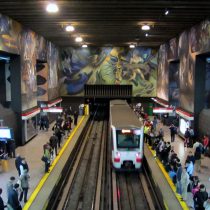
Undoubtedly, September is a month of great symbolic thickness in the future of our homeland, from its very origins. Many of his tragic events must be remembered, since what is not assumed cannot be redeemed.
On September 11, 1541, the lonco or curaca Michimalonco, along with five thousand or ten thousand Picunche warriors from the Aconcagua Valley, attacked the newly founded capital of Chile, Santiago de la Nueva Extremadura, destroying it almost completely. On September 11, 1973, all the Armed Forces and Carabineros, led by Generals Augusto Pinochet, Gustavo Leigh, José Toribio Merino and César Mendoza, perpetrated a coup d’état, overthrowing socialist President Salvador Allende and the Popular Unity government, which began the military dictatorship that would last seventeen years. This could be a simple coincidence. But let’s see.
In the Metro Universidad de Chile station, there is a spectacular mural of 1,200 square meters called Visual Memory of a Nation, by the Chilean painter Mario Toral. This great work is thematically divided into two parts: past and present, which correspond to the eastern and western sectors of the station, at the level of the platforms, separated by the mesanina. Interesting to know that in 2011, the tourist travel publisher Lonely Planet named this station one of the 10 “most artistic in the world”. Greater merit to know that it was the only one selected from Latin America. This mural reviews the history of Chile, from its pre-Columbian past, the wars of conquest, independence to culminate in the last fragment -to the northwest-, called El Conflicto, where an airplane is seen from the sky punishing with its avenging ray of fire to the Palacio de la Moneda.
This iconography mysteriously resembles the Mapuche mythological imaginary of the Pillanes, flaming and fiery beings, condemned to live inside the volcanoes after unleashing a long and great battle between the ancient pillanes, punishing the earth and the losers with their avenging ray. The Wangulén mothers wept when they saw the shattered bodies of their children on the ground and began to mourn and cry. Because of this, the Pu-am spirit was moved and decided to regain balance. It is no coincidence that the first Chilean aircraft manufactured by the Chilean company ENAER for basic military training is called Pillán.
On the day of the coup, it is said that Salvador Allende, seeing the imminence of the abrupt end of democracy in Chile, went to the Gallery of the Presidents of the Palacio de la Moneda, which housed the busts of the 30 presidents who ruled the country since independence, and was throwing them to the ground, leaving only standing that of President Manuel Balmaceda (who on September 19, 1891, the day after serving his presidential term, he committed suicide, shooting himself in the zien.) The other bust that did not break was that of President Pedro Aguirre Cerda, who is remembered for the claim and possession of the Chilean Antarctic territory, the creation of the Corfo and the great impulse given to education, under his slogan “to govern is to educate”, and who would not end his term due to premature death in November 1941. All this, 48 years ago.
On September 4, 1821, General José Miguel Carrera was shot in Mendoza, when he was caught in his attempt to return to Chile. Father of the country who had been president of the provisional government junta, more or less, between 1811 and 1814. Recall that the foundation of the First National Government Junta had also been on September 18, 1810, and that the process of independence of Chile from the Spanish crown had begun.
A little more than a hundred years after republican life, on September 4, 1924, a group of young Army officers went to the galleries of the Senate in order to express their opposition to the approval of the parliamentary diet and the postponement of the processing of social laws. They slammed their sabers against the ground as a sign of defiance and support for the social agenda of President Arturo Alessandri Palma. On September 5, 1924, General Luis Altamirano came to the political fore, delivering a list of demands that favored Army officers. President Alessandri wanted to present his resignation, which was not accepted, but he was given 6 months of leave to leave the country, and in the early morning of the 9th he took up with his family in the diplomatic headquarters of the United States. Precipitated events, Altamirano had been appointed Minister of the Interior after September 5 and was sworn in as vice president of the Republic on September 9.
On September 11, 1924, he gave a coup d’état together with General Juan Pablo Bennett and Admiral Francisco Nef, after which he formed a Government Junta, de facto overthrowing President Arturo Alessandri and also decreeing that same day the dissolution of the National Congress, after 93 years of uninterrupted operation. This Government Junta that Altamirano presided over, governed the nation between September 11, 1924 and January 23, 1925.
A few years later, in a much less known event – and also forgotten – was the uprising of the Squadron, following a mutiny and union mobilization led by the whole of the marines of the Chilean Navy, between August 31 and September 7, 1931. The movement was born as a protest against a sharp reduction in wages, which had been decreed by the government of Vice President Manuel Trucco, in the midst of the economic and political crisis that Chile was going through, following the Great Depression of 1929. The Air Force bombed the squadron that was anchored in the bay of Coquimbo – and also in Talcahuano – on September 6, 1931. Finally, the mutineers capitulated. There were several dead and some shot.
On September 5, 1938, the massacre perpetrated in Santiago and known as La Matanza del Seguro Obrero, against members of the National Socialist Movement of Chile, who were trying to carry out a coup d’état against the government of Arturo Alessandri and favorable to former President Carlos Ibáñez del Campo. The students who belonged to this movement, barricaded themselves in the building of the Caja de Seguro Obrero in front of the Palacio de La Moneda and were massacred by the police after surrendering, in an event that strongly moved public opinion. Ibáñez went into exile again and the discredit of the government grew for this unnecessary massacre. The result of this was the support given by the Ibañistas and Nazis to the Popular Front, decisive in the victory of Aguirre Cerda and the arrival of the Popular Front to the government.
That said, we can go back to the days that proceeded to September 11, 1973. A notable fact is the destruction of the film material of the chile films studios that same September 11 and the public burning of leftist literature. Congress is closed for seventeen years. The Civic axis that made up the Bulnes axis and Morandé Street is closed, which notably articulated the Executive (the Currency), Judicial (Courts of the Supreme Court) and Legislative (Parliament) powers. The Government Palace is closed, where it will no longer be possible to travel until the reopening made by President Lagos.
The place of the last photo of President Salvador Allende alive, and also where his mortal remains were taken, was the door of Morandé 80, which after the reconstruction of the palace, was covered by order of Augusto Pinochet, in such a way as to avoid its symbolism. However, the address of that door was used as a symbol by the supporters of Allende and popular unity, by laying a wreath each year where that access had been, which went on to become a window. On September 11, 2003, thirty years after the military coup, President Ricardo Lagos reopened the door during a televised ceremony, along with freeing pedestrian traffic through the interior of La Moneda, but it was later closed again. In addition, a comprehensive constitutional reform was enacted. “We have a Constitution that no longer divides us, it is a very big day for Chile. Today we finally have a democratic Constitution,” the Socialist President said at the time. Traditionally, through this entrance presidents could enter domestically, it was also where they left in a symbolic way, after finishing their term.
Augusto Pinochet had closed the continuity of the civic axis of Bulnes, putting an elevated pedestal where he placed the statue of the liberator, General Bernardo O’Higgins, and in 1978 he inaugurated the Altar of the Fatherland, where the Eternal Flame of Freedom was lit between 1982 and 2004. Curiously, the most guarded flame in Chile, which cuts the visual continuity of the Palacio de la Moneda from Bulnes, that is, symbolically the democratic axis designed by Karl Brunner, in the time of President Ibáñez del Campo, was cut. Ricardo Lagos, a deep connoisseur of symbolism – like Augusto Pinochet – demolishes the basement, sets aside the statue of O’Higgins and removes the Flame of Freedom. Later, during the bicentennial of independence, in September 2010, President Sebastián Piñera added to the other side of the Bulnes axis with the Alameda, the image of José Miguel Carrera, the work of Héctor Román. With this, a gesture of repair was made.historical and symbolic reconciliation and reconciliation of two factions of patriots divided by the independence process.
Another gesture no less, was the willingness of General Pinochet to move the Congress out of the capital, taking it to Valparaíso, with the argument of decentralizing the country, which was also understood as a symbolic exile of the political oligarchy, to which Pinochet, without concealing it, detested “with very few exceptions”, as he used to say.
Finally, on September 11, 2001, the attacks on the Twin Towers, in New York, and the Pentagon, in Washington, as well as a plane in Shanksville, Pennsylvania, left 3,016 dead. This episode preceded the war in Afghanistan and the adoption by the George W. Bush administration and its allies of the so-called “war on terror” policy. Again, those Pillanes, flaming and fiery beings unleashed a long and great battle between the ancient Pillanes, punishing from heaven, to earth with their avenging ray. That day in 2011 – in the face of horror and bewilderment – seemed like the day our eleven had been stolen.
The content expressed in this opinion column is the sole responsibility of its author, and does not necessarily reflect the editorial line or position of El Mostrador.





